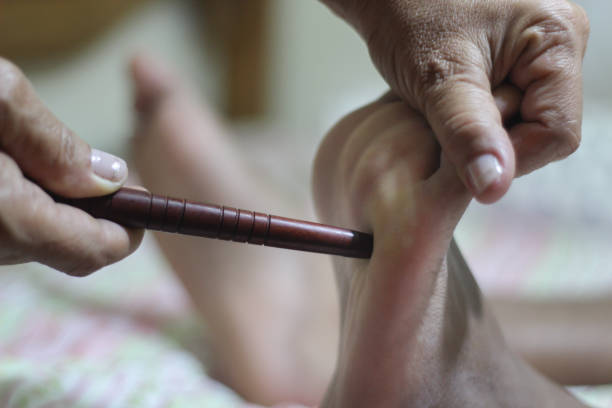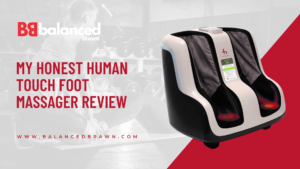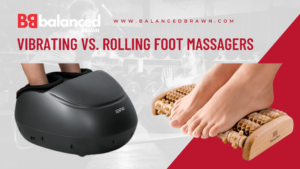Table of Contents
Our feet work tirelessly every day, carrying our full body weight while we walk, run, stand, and more. It’s no surprise that they can often feel sore, achy, and fatigued. This is where the ancient practice of foot massage can provide incredible relief and rejuvenation. From reducing stress and improving sleep to alleviating aches and pains, foot massages offer a wealth of benefits for our overall well-being.
This comprehensive guide will explore different foot massage techniques, acupressure points, and the science behind why these practices are so powerful. Whether you’re new to foot massage or looking to enhance your existing routine, you’ll gain valuable insights to unlock the full potential of this revitalizing ritual.
Foot Massage for Better Sleep

Struggling with insomnia, restlessness, or disturbed sleep? Look no further than your feet! Specific points on the soles of your feet correspond to relaxation when massaged properly. Applying pressure to these areas can calm your mind, release tension, and prepare your body for restorative slumber.
One key area is the “Yongquan” point, located in the indentation below the ball of each foot. Gently massaging this point in a circular motion for 2-3 minutes can promote deep relaxation and better sleep quality. The “Bubbling Spring” points, situated at the joints where your big toes meet the foot, are also believed to reduce stress and induce a state of tranquility when stimulated through massage.
Establish a calming pre-bedtime routine by slowly and deliberately massaging these points for 5-10 minutes while practicing deep breathing exercises. Not only can this help lull you into a peaceful slumber, but the ritual itself can become a soothing, mindful experience to wind down from a busy day.
Acupressure Points on the Feet

Acupressure is an ancient Chinese practice based on the idea that specific points on the body, when stimulated through pressure, can alleviate various ailments and discomforts. The feet are particularly rich in acupressure points, making them an ideal target for massage techniques aimed at addressing a wide range of concerns.
For headache and migraine relief, focus on massaging the areas between the big toe and second toe, as well as the fleshy regions just below the base of the toes. These points correspond to releasing tension in the head and neck regions. Similarly, massaging the inner edges of the feet near the arches can provide relief for digestive issues like bloating, constipation, and nausea.
Those seeking to reduce stress, anxiety, and promote a sense of calm should concentrate on the center of the ball of each foot, as well as the regions below the pads of the toes. Spend 2-3 minutes gently but firmly pressing into these areas using a circular kneading motion.
While acupressure is generally safe, it’s essential to avoid massaging any areas with open wounds, bruises, or excessive swelling. It’s also recommended to consult a healthcare professional if you have a chronic condition or experience severe, persistent pain during or after acupressure.
Why Foot Massages Can Be Painful Initially

Have you ever experienced temporary discomfort or even soreness after your first few foot massages? This phenomenon is not only common but can actually indicate that the massage is effectively releasing long-held tension and trigger points in the feet.
Our feet contain a high concentration of nerve endings, as well as a complex network of muscles, tendons, and ligaments that can become tight and knotted over time due to strain from activities like walking and standing. When you begin to apply sustained pressure through massage, you may experience some initial discomfort as these trigger points are released and lactic acid buildup is dispersed.
In many cases, this temporary pain or achiness is a positive sign – it means that the massage is effectively increasing circulation and breaking up adhesions in the feet. However, it’s crucial to communicate with your massage therapist if the pain becomes intense or persists beyond the session itself. Severe or prolonged pain could indicate a more serious condition that requires medical attention.
To minimize discomfort during and after a foot massage, be sure to properly warm up your feet beforehand through gentle stretching or a warm water soak. Staying hydrated and engaging in light post-massage activity, such as walking or ankle rotations, can also help alleviate residual soreness as circulation improves.
Foot Massage Techniques

While giving yourself or a loved one a simple foot rub can provide relaxation, truly reaping the full benefits of foot massage requires an understanding of specific techniques. Here are some of the most effective and commonly used methods:
– Effleurage (Stroking)
This foundational technique involves gently gliding your hands in long, fluid strokes along the entire surface of the foot. Not only does this help increase circulation, but it also serves to warm up the tissues and prepare for deeper massage.
– Petrissage (Kneading)
Using your thumbs and fingertips, lift and gently squeeze sections of the foot, working from the toes down towards the heel. This kneading motion helps work out knots and adhesions in the muscle tissues.
– Friction
Focusing on specific areas like the arches or balls of the feet, apply firm pressure in a circular, back-and-forth motion using your thumbs. This cross-fiber friction technique helps release tension in tight bands of connective tissue.
– Compression
With your hands cupping the entire foot, apply firm but comfortable squeezing pressure for several seconds before releasing. Repeat this compression technique to stimulate circulation and relax the muscles and tendons.
– Vibration
While grasping the foot with both hands, gently shake or vibrate the tissues. This can help loosen up deeply embedded knots and adhesions that are difficult to access through other techniques alone.
For an enhanced massage experience, consider incorporating massage tools like wooden foot rollers, spiky massage balls, or even ergonomic foot cradles designed to provide optimal leverage and pressure. Be sure to use a high-quality massage oil or lotion to facilitate smooth, gliding strokes.
Bottom Line
Proper technique is essential for both effectiveness and safety, so consider taking a foot massage class or referring to instructional videos to ensure you’re executing these methods correctly. Overexertion or improper application can lead to tissue damage, so it’s crucial to maintain a gentle yet firm pressure.
Remember, consistency is key when it comes to reaping the full benefits of foot massage. Aim to incorporate even just 5-10 minutes of self-massage into your daily routine, focusing on areas of particular tightness or discomfort. You may be amazed at how quickly this simple practice can become a treasured ritual for relaxation, pain relief, and overall rejuvenation.
If you’re seeking deeper relief from neuropathy, check out our guide, “Can Foot Massagers Help Relieve Neuropathy? Top Doctor-Recommended Models,” for maximum benefits.
Unlock a world of relaxation, improved circulation, and holistic well-being by incorporating these powerful foot massage techniques and acupressure points into your self-care routine today!








Pingback: Foot Massage Side Effects: What the Experts Want You to Know! - Balanced Brawn